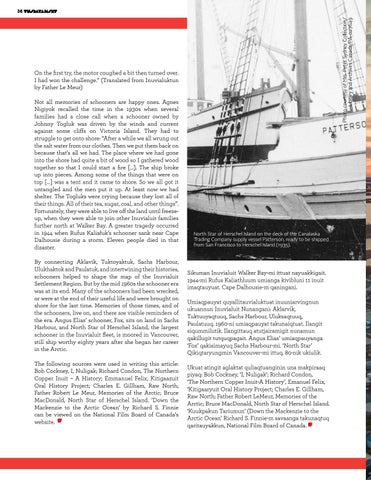Photo courtesy of Mrs. Peter Sydney Collection/ Library and Archives Canada/PA-027649
36
On the first try, the motor coughed a bit then turned over. I had won the challenge.” (Translated from Inuvialuktun by Father Le Meur) Not all memories of schooners are happy ones. Agnes Nigiyok recalled the time in the 1930s when several families had a close call when a schooner owned by Johnny Togluk was driven by the winds and current against some cliffs on Victoria Island. They had to struggle to get onto shore: “After a while we all wrung out the salt water from our clothes. Then we put them back on because that’s all we had. The place where we had gone into the shore had quite a bit of wood so I gathered wood together so that I could start a fire […]. The ship broke up into pieces. Among some of the things that were on top […] was a tent and it came to shore. So we all got it untangled and the men put it up. At least now we had shelter. The Togluks were crying because they lost all of their things. All of their tea, sugar, coal, and other things”. Fortunately, they were able to live off the land until freezeup, when they were able to join other Inuvialuit families further north at Walker Bay. A greater tragedy occurred in 1944 when Rufus Kaliałuk’s schooner sank near Cape Dalhousie during a storm. Eleven people died in that disaster. By connecting Aklavik, Tuktoyaktuk, Sachs Harbour, Ulukhaktok and Paulatuk, and intertwining their histories, schooners helped to shape the map of the Inuvialuit Settlement Region. But by the mid 1960s the schooner era was at its end. Many of the schooners had been wrecked, or were at the end of their useful life and were brought on shore for the last time. Memories of those times, and of the schooners, live on, and there are visible reminders of the era. Angus Elias’ schooner, Fox, sits on land in Sachs Harbour, and North Star of Herschel Island, the largest schooner in the Inuvialuit fleet, is moored in Vancouver, still ship worthy eighty years after she began her career in the Arctic. The following sources were used in writing this article: Bob Cockney, I, Nuligak; Richard Condon, The Northern Copper Inuit – A History; Emmanuel Felix, Kitigaazuit Oral History Project; Charles E. Gillham, Raw North; Father Robert Le Meur, Memories of the Arctic; Bruce MacDonald, North Star of Herschel Island. ‘Down the Mackenzie to the Arctic Ocean’ by Richard S. Finnie can be viewed on the National Film Board of Canada’s website.
North Star of Herschel Island on the deck of the Canalaska Trading Company supply vessel Patterson, ready to be shipped from San Francisco to Herschel Island (1935).
Sikuman Inuvialuit Walker Bay-mi ittuat nayuakkigait. 1944-mi Rufus Kaliathluum umianga kivibluni 11 inuit imaqtauyuat. Cape Dalhousie-m qaningani. Umiaqpauyat quyallitauvialuktuat inuuniarvingnun ukuannun Inuvialuit Nunangani: Aklarvik, Tuktuuyaqtuuq, Sachs Harbour, Uluksaqtuuq, Paulatuuq. 1960-ni umiaqpauyat takunaiqtuat. Ilangit siqummilutik. Ilangittauq atutjairamigit nunamun qakillugit tutquqpagait. Angus Elias’ umiaqpauyanga ‘Fox’ qakisimayuq Sachs Harbour-mi. ‘North Star’ Qikiqtaryungmin Vancouver-mi ittuq. 80-nik ukiulik. Ukuat atingit aglaktat quliaqtuanginin una makpiraaq piyaq: Bob Cockney, ‘I, Nuligak’; Richard Condon, ‘The Northern Copper Inuit-A History’, Emanuel Felix, ‘Kitigaaryuit Oral History Project; Charles E. Gillham, Raw North; Father Robert LeMeur, Memories of the Arctic; Bruce MacDonald, North Star of Herschel Island. ‘Kuukpakun Tariumun’ (Down the Mackenzie to the Arctic Ocean’ Richard S. Finnie-m savaanga takunaqtuq qaritauyakkun, National Film Board of Canada.

